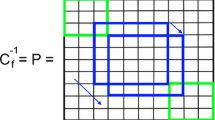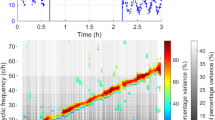Abstract
A procedure for time-frequency analysis of time series is described, which is mainly inspired by singular-spectrum analysis, but it presents some modifications that allow checking the convergence of the results and extracting the detected spectral components through a more efficient technique, especially for real applications. This technique is adaptive, completely data dependent with no a priori assumption and applicable to non-stationary signals. The principal components are extracted from the signals and sorted by their fluctuating energy; moreover, the time variation of their amplitude and frequency is characterized. The technique is first assessed for multi-component computer-generated signals and then applied to experimental velocity signals. The latter are acquired in proximity of the wake generated from a triangular prism placed vertically on a plane, with a vertical edge against the incoming flow. From these experimental signals, three different spectral components, connected to the dynamics of different vorticity structures, are detected, and the time histories of their amplitudes and frequencies are characterized.
























Similar content being viewed by others
References
Bendat JS, Piersol AG (1986) Random data: analysis and measurement procedures, 2nd edn. Wiley, New York
Broomhead D, King G (1986) Extracting qualitative dynamics from experimental data. Phys D 20:217–236
Buffoni M, Camarri S, Iollo A, Salvetti MV (2006) Low-dimensional modelling of a confined three-dimensional wake flow. J Fluid Mech 569:141–150
Buresti G, Iungo GV (2010) Experimental investigation on the connection between flow fluctuations and vorticity dynamics in the near wake of a triangular prism placed vertically on a plane. J Wind Eng Ind Aerodyn 98:253–262
Buresti G, Lombardi G, Bellazzini J (2004) On the analysis of fluctuating velocity signals through methods based on the wavelet and Hilbert transforms. Chaos Solitons Fractals 20:149–158
Camarri S, Salvetti MV, Buresti G (2006) Large-eddy simulation of the flow around a triangular prism with moderate aspect-ratio. J Wind Eng Ind Aerodyn 94(5):309–322
Carmona R, Hwang WL, Torresani B (1998) Practical time-frequency analysis. Academic Press, San Diego
Flandrin P, Rilling G, Gonçalvès P (2004) Empirical mode decomposition as a filter-bank. IEEE Signal Process Lett 11:112–114
Huang NE, Shen Z, Long SR, Wu MC, Shih HH, Zheng Q, Yen N, Tung CC, Liu HH (1998) The empirical mode decomposition and the Hilbert spectrum for non-linear and non-stationary time series analysis. Proc R Soc Lond Ser A Math Phys Eng Sci 454(1971):903–995
Huang NE, Wu Z, Long SR, Arnold KC, Chen X, Blank K (2009) On instantaneous frequency. Adv Adapt Data Anal 1(2):177–229
Iungo GV, Skinner P, Buresti G (2009) Correction of wandering smoothing effects on static measurements of a wing-tip vortex. Exp Fluids 46(3):435–452
Lumley JL (1970) Stochastic tools in turbulence. Academic Press, New York
Olhede S, Walden AT (2004) The Hilbert spectrum via wavelet projections. Proc R Soc Lond A 460:955–975
Pastur LR, Lusseyran F, Faure TM, Fraigneau Y, Pethieu R, Debesse P (2008) Quantifying the nonlinear mode competition in the flow over an open cavity at medium Reynolds number. Exp Fluids 44:597–608
Sirovich L (1987) Turbulence and the dynamics of coherent structures. Part I–III. Q Appl Math 45:561–590
Sreenivasan KR (1985) On the finite-scale intermittency of turbulence. J Fluid Mech 151:81–103
Vautard R, Yiou P, Ghil M (1992) Singular-spectrum analysis: a toolkit for short, noisy chaotic signals. Phys D 58:95–126
Acknowledgments
The authors would like to thank G. Buresti and L. Carassale for their invaluable suggestions and their contribution to the paper writing. Thanks are also due to M. V. Salvetti and to L. M. Pii.
Author information
Authors and Affiliations
Corresponding author
Rights and permissions
About this article
Cite this article
Iungo, G.V., Lombardi, E. A procedure based on proper orthogonal decomposition for time-frequency analysis of time series. Exp Fluids 51, 969–985 (2011). https://doi.org/10.1007/s00348-011-1123-1
Received:
Revised:
Accepted:
Published:
Issue Date:
DOI: https://doi.org/10.1007/s00348-011-1123-1




